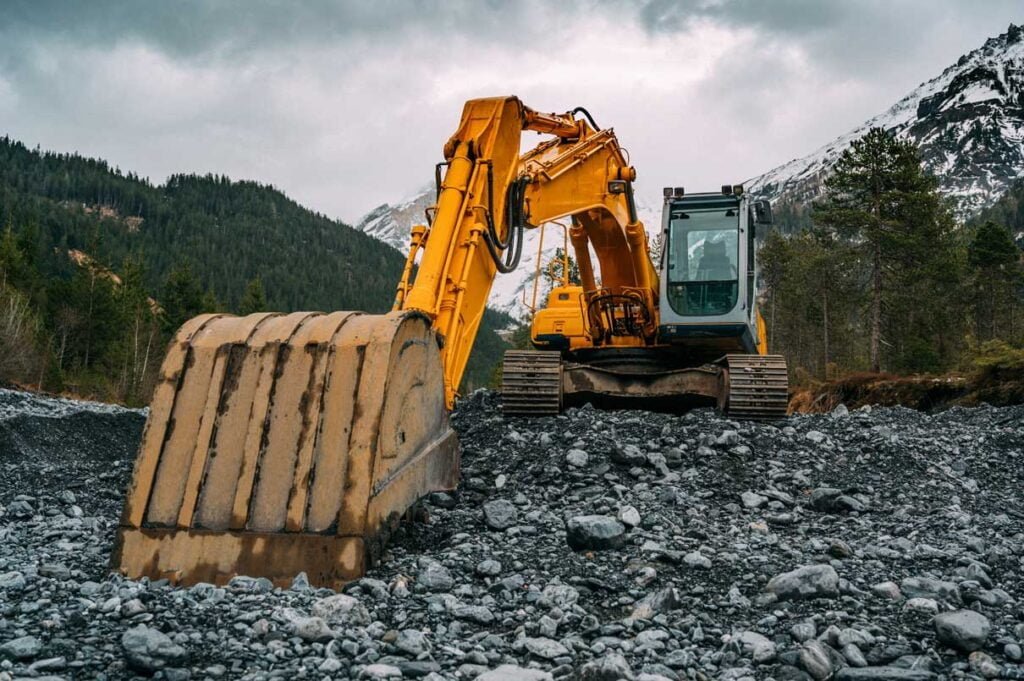Modern excavators, those mighty machines that seem to effortlessly move tons of earth and debris, have become an indispensable tool in the world of construction. With their incredible power and precision, they make light work of digging, lifting, and demolishing. But have you ever wondered how these marvels of engineering actually work? Or perhaps you’re curious about the vast range of applications where excavators prove their worth? Look no further! In this blog post, we’ll delve into the working principle behind excavators and explore the diverse fields where they play a crucial role. So buckle up as we embark on an exciting journey to uncover the secrets of these remarkable machines!

What is an excavator?
An excavator is a heavy-duty construction machine that is primarily used for digging, lifting, and moving large amounts of earth or other materials. It typically consists of a cab mounted on tracks or wheels, with a long arm called the boom attached to it. At the end of the boom is an attachment known as the bucket, which can be changed depending on the specific task at hand.
The heart of an excavator lies in its hydraulic system. This system powers the movement of various components such as the boom, bucket, and tracks/wheels. By utilizing hydraulic fluid under pressure, an operator can control these movements with precision using joysticks or pedals located inside the cab.
Excavators come in various sizes and configurations to cater to different project requirements. Mini-excavators are compact and nimble machines perfect for small-scale jobs like landscaping or utility work. On the other end of the spectrum are large excavators that pack immense power for heavy-duty tasks such as mining or major construction projects.
One notable feature of modern excavators is their versatility. Besides digging trenches or foundations, they can also be equipped with attachments like hammers for breaking concrete, grapples for handling rocks or logs, and even augers for drilling holes.
With their impressive capabilities and adaptability across industries ranging from construction to forestry to agriculture, it’s no wonder that excavators have become indispensable tools in many fields. Whether it’s building roads and bridges, demolishing structures safely and efficiently,
or even assisting in disaster relief efforts by clearing debris after natural disasters – there seems to be no limit to what these mighty machines can accomplish!
So next time you drive by a construction site adorned with towering cranes and bustling workers,
take a moment to appreciate those hard-working modern excavators – silently but effectively shaping our world one scoop at a time!
How does an excavator work?
Excavators are powerful machines that play a crucial role in construction and mining projects. But have you ever wondered how these impressive pieces of equipment actually work? Let’s dive into the fascinating world of excavators and explore their working principle.
At its core, an excavator is essentially a hydraulic machine that operates using a combination of hydraulic fluid, mechanical power, and intricate engineering. The main components include the boom, arm, bucket, and cab where the operator controls the machine.
The process starts with the engine providing power to drive both the hydraulic pump and other mechanical components. This pump then forces hydraulic fluid through various valves and cylinders to create movement in different parts of the excavator.
When it comes to digging or lifting heavy objects, it’s all about hydraulics. As pressure builds up in specific cylinders controlled by valves, it causes pistons to move back and forth. These movements enable smooth operation of the boom, arm, bucket, or any attachments used for specialized tasks like demolition or drilling.
To control these movements precisely, operators use joysticks or foot pedals located inside the cab. They manipulate these controls to direct hydraulic flow as needed for excavation tasks. It requires skillful coordination between hand-eye-foot coordination!
This impressive machinery relies on sophisticated engineering principles combined with advanced hydraulics technology to perform various functions efficiently on construction sites worldwide!
What are the different types of modern excavators?
When it comes to excavators, there are several different types available, each designed for specific purposes and projects. One of the most common types is the standard excavator, which features a boom arm and bucket attachment that can dig deep into the ground or scoop up materials. These excavators are versatile and widely used in construction projects.
Another type of excavator is the mini-excavator, also known as a compact or small-sized excavator. These machines are perfect for jobs that require maneuverability in tight spaces or lighter digging tasks. Mini-excavators are often seen on residential construction sites, landscaping projects, and even indoor renovations.
For larger-scale excavation work, there are also hydraulic excavators. These heavy-duty machines use hydraulic power to operate various attachments such as buckets or demolition tools. They can handle more demanding tasks like digging trenches, demolishing structures, or moving large amounts of earth.
In addition to these main types of excavators, there are specialized variants tailored for specific applications like dredging (dredgers), mining (dragline excavators), forestry (log loaders), and many more.
By understanding the different types of excavators available on the market today, you can choose the one that best suits your project’s needs – whether it’s a small backyard renovation or a massive construction site requiring heavy-duty machinery. Each type offers unique capabilities and features to ensure efficient and effective excavation operations.
What are the benefits of using an excavator?
Excavators are versatile machines that offer a multitude of benefits for various applications. One of the key advantages of using an excavator is their ability to efficiently and quickly complete digging tasks. With their powerful hydraulic systems, these machines can easily break through tough soil and rocks, making excavation projects more manageable.
Another benefit of using an excavator is their adaptability. These machines come in different sizes and configurations, allowing them to be used in various environments and working conditions. Whether you need to dig trenches for utilities or clear land for construction projects, there’s an excavator that can meet your specific requirements.
Excavators also provide enhanced precision and control over excavation operations. Equipped with advanced technology such as GPS guidance systems, operators can accurately position the bucket or attachment exactly where it needs to be. This level of accuracy helps minimize errors and improves overall efficiency on the job site.
Additionally, excavators can significantly increase productivity by reducing manual labor requirements. Instead of relying solely on manpower to complete demanding digging tasks, these machines allow operators to work smarter not harder. This means faster project completion times and reduced costs associated with labor-intensive processes.
Furthermore, safety is a top priority when it comes to operating heavy machinery like excavators. These machines are designed with safety features such as rollover protection structures (ROPS) and falling object protection structures (FOPS), ensuring operator safety during operation.
The benefits of using an excavator include increased efficiency, adaptability to different working conditions, enhanced precision and control over excavation operations, improved productivity by reducing manual labor requirements,and prioritizing operator safety on the job site
What are the different applications for excavators?
Excavators are incredibly versatile machines that can be used in a wide range of applications. From construction sites to mining operations, these powerful pieces of equipment are essential for completing various tasks efficiently and effectively.
One common application for excavators is digging trenches or foundations. Their ability to dig deep into the ground quickly makes them ideal for creating solid bases for structures such as buildings and roads. Excavators can also be used to remove unwanted materials from excavation sites, like rocks, soil, or debris.
Another use for excavators is in landscaping projects. With their precision and maneuverability, they can easily shape and contour the land according to desired specifications. Whether it’s leveling out an uneven terrain or creating ponds and ditches, excavators make landscape transformations possible.
In the agricultural industry, excavators play a crucial role in tasks such as clearing land, building irrigation systems, or constructing animal housing structures. Their robust nature allows them to handle heavy loads while performing tasks with accuracy and efficiency.
Excavators are also utilized in demolition work where old structures need to be dismantled safely and swiftly. The hydraulic-powered attachments on excavator arms enable operators to break down walls or concrete structures with ease.
Additionally, these machines find extensive use in mining operations. They assist in extracting minerals from mines by removing overburden material or digging tunnels underground.
These examples only scratch the surface of what excavators can do; their versatility extends far beyond these applications. With the right attachments and skilled operator at hand, there’s no limit to what an excavator can achieve on various job sites across different industries!
How to choose the right excavator for your project
When it comes to choosing the right excavator for your project, there are several factors that you need to consider. First and foremost, you need to assess the size of your project and determine the scope of work that needs to be done. This will help you determine what size excavator is needed.
Next, think about the specific requirements of your project. Are you digging trenches or working in tight spaces? In this case, a compact or mini excavator would be more suitable. On the other hand, if you have a large-scale excavation project, a standard excavator with greater digging depth and reach would be more appropriate.
Consider the terrain and conditions in which the excavator will be operating. If you’re working on rough or uneven surfaces, opt for an excavator with good stability and traction capabilities. Additionally, take into account any additional attachments or accessories that may be required for your specific tasks.
Budget is another important factor when choosing an excavator. Determine how much you are willing to invest in equipment rental or purchase based on your budget constraints.
Don’t forget about operator comfort and safety features. Look for an excavator with ergonomic controls and visibility enhancements to ensure efficiency and minimize accidents on site.
By carefully considering these factors, you can choose the right excavator that meets all your project requirements efficiently!
Conclusion
modern excavators are powerful and versatile machines that play a crucial role in various industries. Their working principle involves using hydraulic power to dig, lift, and move heavy materials with precision. With different types of excavators available, such as the standard excavator, mini-excavator, and long-reach excavator, you can choose the one that best suits your project requirements.
The application fields for excavators are extensive. From construction sites to mining operations, from landscaping projects to demolition work, these machines prove their worth time and again. They excel at digging foundations for buildings, trenches for pipelines or cables, clearing debris after natural disasters or accidents; the possibilities are endless.
When selecting an excavator for your project, consider factors like size and weight capacity based on the job site conditions and scope of work. Assess whether you need additional attachments like buckets or breakers to enhance its capabilities further.
Remember that safety should always be a priority when operating an excavator. Ensure that operators undergo proper training to handle these machines safely and efficiently.
So whether you’re involved in construction projects big or small or tackling any other task requiring heavy-duty excavation work, an excavator is undoubtedly a valuable asset to have on hand.
Harnessing their strength and performance will not only save time but also boost productivity while ensuring accurate results. So go ahead and explore the world of excavation with confidence!

